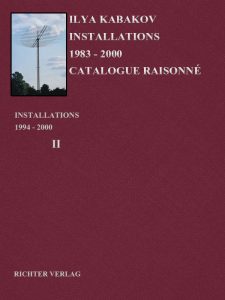The Happiest Man
with Emilia Kabakov
YEAR: 2000
CATALOG NUMBER: 148
PROVENANCE
Collection of the artist (on loan to a private collection in France)
EXHIBITIONS
Paris, Galerie Nationale du Jeu de Paume
L’autre moitié de l’Europe, 13 Mar 2000 — 9 Apr 2000
DESCRIPTION
From the outside, the installation looks like an elongated parallelepiped, 17 meters in length. From one side there is an entrance into it in the form of a small attachment with two steps. The viewer, upon entering, winds up inside a movie theater where a color film is playing on a widescreen arranged just below the ceiling. Semidarkness reigns in the dwelling, but by the light from the screen, the viewer can easily find his way around. Everything is like in an ordinary movie theater: the floor is slightly sloped, the walls are painted a simple, ‘provincial’ color, there is an aisle between rows of seats. But inside the hall, one notices what doesn’t exist in a ‘normal’ movie theater: to the right of the entrance is a small dwelling built into the hall, closed in on all sides by walls, with a semi-opened door leading into it. Taking a look inside, the viewer sees something before him that is very unusual. He sees an ordinary residential room, with poor but perfectly decent furnishings: a table with plates and glasses, a bed, chairs, a wardrobe and a bookshelf, pictures on the walls, and a lampshade hanging from the ceiling … In a word, a normal, modest human room with a single window on the wall opposite the entrance.
A bit more detail about the window is warranted here, for it is the main element of the entire installation. The window is a horizontal, rectangular hole cut out of the wall. This ‘window’ opens out into the very same theater hall. Through it you can see the rows of seats. But the whole essence is the fact that if you sit down in the comfortable armchair standing near the table or on the couch, then from this ‘window’ you can see the entire screen and everything happening on it, so to speak, without leaving the comfort of your own ‘private’ residence. What others see ‘publicly,’ you can view as well while preserving the illusion of your individual environment, using all the advantages of your ‘domestic’ existence.
Why the installation is called The Happiest Man becomes clear. The watching of a film in the movie theater (precisely in the movie theater and not on the television) forces us to submerge into a deep sleep, where we see wonderful or horrible visions, to be in another world, to experience a story which, it seems, is happening to us. But when the show is over, when the lights are turned on, there are gray seats of a movie theater all around us, and we go outside. Our depressing everyday reality returns once again.
But none of this happens with the personage who has built his own room into the theater hall. An awakening, in reality, doesn’t threaten him. His life – with his books, bed, all his things – is forever included, ‘melded’ into a world of sleep, his ‘window’ to the world looks out onto a perpetual dream-fairy tale – one fairy tale following after another on the screen. This screen, illuminating via the window his entire room, fulfills the role of the sun, imparting to his life a phantasmal, but nonetheless very vivid, magical, all-encompassing meaning.
The main thing is that this magical life isn’t interrupted by ‘shows.’ One film follows another, repeating or being new. The public, like the tide, either fills or abandons the hall beyond the window, hundreds of faces appear and disappear beyond its walls. But the place and the state of the ‘personage’ remain eternally the same – in that marvelous spot of happiness, satisfaction, and peace which he has found forever.
Our century is coming to an end, a century which among other things, can be called the century of illusions, the century of a desire of people to hide from reality, to escape into a magical, fairytale world. This desire is best fulfilled today by the cinema, and along with it the television in this emerging epoch of ‘virtual reality.’ The proposed installation represents a unique kind of metaphor: a concentrated, condensed, sad and yet ironic image of this situation, of this problem.
Once inside the installation, the viewer can, if he wishes, submerge himself into this dream which is ordinary for him. But he can also see this entire situation ‘from the side.’
Two words about the film which will ‘run’ on the screen all the time without interruption. This is one of the ‘ordinary’ color Hollywood films, entirely banal in its content. But the movie is to be shown only in a 15-minute fragment, after which this same fragment will repeat over and over – the viewer is not supposed to forget, after all, that he is not in a ‘real’ movie theater, but in an installation ‘depicting’ such a movie theater.
Images
Literature







